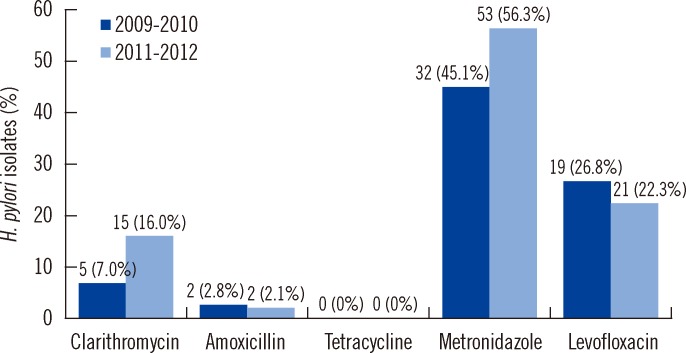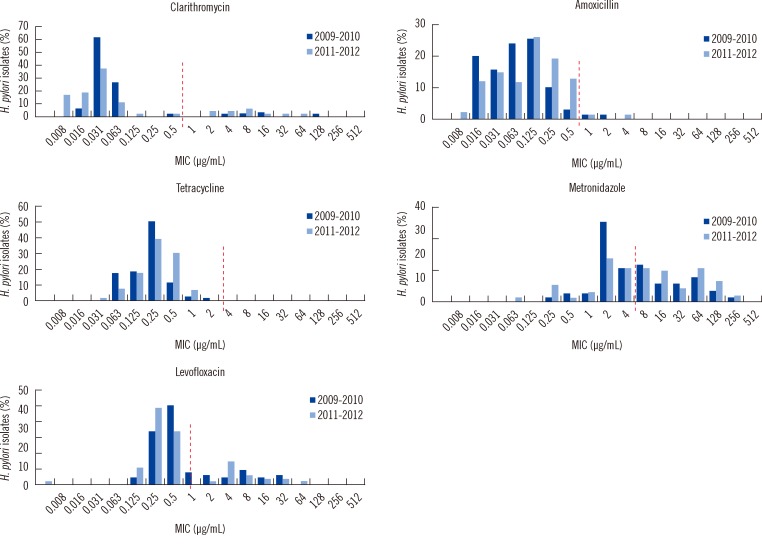Ann Lab Med.
2013 Nov;33(6):415-419. 10.3343/alm.2013.33.6.415.
Antibiotic Resistance in Helicobacter pylori Strains and its Effect on H. pylori Eradication Rates in a Single Center in Korea
- Affiliations
-
- 1Department of Laboratory Medicine, Yongin Severance Hospital, Yongin, Korea.
- 2Department of Internal Medicine, Yonsei University College of Medicine, Seoul, Korea.
- 3Department of Laboratory Medicine, Yonsei University College of Medicine, Seoul, Korea.
- 4Department of Biomedical Laboratory Sciences, College of Health Science, Yonsei University, Wonju, Korea. kimjb70@yonsei.ac.kr
- KMID: 1711314
- DOI: http://doi.org/10.3343/alm.2013.33.6.415
Abstract
- BACKGROUND
Clarithromycin, amoxicillin, metronidazole, tetracycline, and levofloxacin have been commonly used for the eradication of Helicobacter pylori. We compared the change in antibiotic resistance of H. pylori strains during two separate periods and investigated the effect of antibiotic resistance on H. pylori eradication.
METHODS
H. pylori strains were isolated from 71 patients between 2009 and 2010 and from 94 patients between 2011 and 2012. The distribution of minimal inhibitory concentration (MIC) of 5 antibiotics was assessed using the agar dilution method, and H. pylori eradication based on the antimicrobial susceptibility of the isolates was investigated retrospectively.
RESULTS
Antibiotic resistance rate against clarithromycin, amoxicillin, tetracycline, metronidazole, and levofloxacin for the 2009-2010 isolates were 7.0% (5/71), 2.8% (2/71), 0% (0/71), 45.1% (32/71), and 26.8% (19/71), respectively, and for the 2011-2012 isolates were 16.0% (15/94), 2.1% (2/94), 0% (0/94), 56.3% (53/94), and 22.3% (21/94), respectively. Multi-drug resistance for 2 or more antibiotics increased slightly from 16.9% (12/71) in the 2009-2010 isolates to 23.4% (22/94) in the 2011-2012 isolates. In follow-up testing of 66 patients, first-line treatment successfully eradicated H. pylori in 50 patients (75.8%) and failed in 4 of 7 patients (57.1%) in a clarithromycin-resistant and amoxicillin-susceptible group.
CONCLUSIONS
We observed an increase in resistance to clarithromycin and an overall increase in multi-drug resistance during the 2 study periods. The effectiveness of the eradication regimen was low with combinations of clarithromycin and amoxicillin, particularly in the clarithromycin-resistant group. Thus, eradication of H. pylori depends upon periodic monitoring of antimicrobial susceptibility.
MeSH Terms
-
Adult
Aged
Anti-Bacterial Agents/*pharmacology/therapeutic use
Drug Resistance, Multiple, Bacterial/*drug effects
Female
Helicobacter Infections/drug therapy/*microbiology
Helicobacter pylori/*drug effects/isolation & purification
Humans
Male
Microbial Sensitivity Tests
Middle Aged
Peptic Ulcer/diagnosis/microbiology
Republic of Korea
Retrospective Studies
Treatment Outcome
Anti-Bacterial Agents
Figure
Reference
-
1. Sugiyama T, Sakaki N, Kozawa H, Sato R, Fujioka T, Satoh K, et al. Sensitivity of biopsy site in evaluating regression of gastric atrophy after Helicobacter pylori eradication treatment. Aliment Pharmacol Ther. 2002; 16(Suppl 2):187–190. PMID: 11966540.2. Suerbaum S, Michetti P. Helicobacter pylori infection. N Engl J Med. 2002; 347:1175–1186. PMID: 12374879.3. Malfertheiner P, Megraud F, O'Morain C, Bazzoli F, El-Omar E, Graham D, et al. Current concepts in the management of Helicobacter pylori infection: the Maastricht III Consensus Report. Gut. 2007; 56:772–781. PMID: 17170018.4. Kim N, Kim JJ, Choe YH, Kim HS, Kim JI, Chung IS. Diagnosis and treatment guidelines for Helicobacter pylori infection in Korea. Korean J Gastroenterol. 2009; 54:269–278. PMID: 19934608.5. Hwang TJ, Kim N, Kim HB, Lee BH, Nam RH, Park JH, et al. Change in antibiotic resistance of Helicobacter pylori strains and the effect of A2143G point mutation of 23S rRNA on the eradication of H. pylori in a single center of Korea. J Clin Gastroenterol. 2010; 44:536–543. PMID: 20179610.6. Choi YS, Cheon JH, Lee JY, Kim SG, Kim JS, Kim N, et al. The trend of eradication rates of first-line triple therapy for Helicobacter pylori infection: single center experience for recent eight years. Korean J Gastroenterol. 2006; 48:156–161. PMID: 17047430.7. Na HS, Hong SJ, Yoon HJ, Maeng JH, Ko BM, Jung IS, et al. Eradication rate of first-line and second-line therapy for Helicobacter pylori infection, and reinfection rate after successful eradication. Korean J Gastroenterol. 2007; 50:170–175. PMID: 17885282.8. Clinical and Laboratory Standards Institute. Performance standards for antimicrobial susceptibility testing. Eighteenth informational supplement, M2-A9, M7-A7, and M100-S18. Wayne, PA: Clinical and Laboratory Standards Institute;2008.9. Glupczynski Y, Mégraud F, Lopez-Brea M, Andersen LP. European multicentre survey of in vitro antimicrobial resistance in Helicobacter pylori. Eur J Clin Microbiol Infect Dis. 2001; 20:820–823. PMID: 11783701.10. Kim JM, Kim JS, Kim N, Jung HC, Song IS. Distribution of fluoroquinolone MICs in Helicobacter pylori strains from Korean patients. J Antimicrob Chemother. 2005; 56:965–967. PMID: 16159928.11. Kim JM, Kim JS, Jung HC, Kim N, Song IS. Antibiotic resistance of Helicobacter pylori isolated from Korean patients in 2003. Korean J Gastroenterol. 2004; 44:126–135. PMID: 15385720.12. Kim JJ, Reddy R, Lee M, Kim JG, El-Zaatari FA, Osato MS, et al. Analysis of metronidazole, clarithromycin and tetracycline resistance of Helicobacter pylori isolates from Korea. J Antimicrob Chemother. 2001; 47:459–461. PMID: 11266421.13. Eun CS, Han DS, Park JY, Jeon YC, Hahm JS, Kim KS, et al. Changing pattern of antimicrobial resistance of Helicobacter pylori in Korean patients with peptic ulcer diseases. J Gastroenterol. 2003; 38:436–441. PMID: 12768385.14. Lee HK, Chae HS, Kang JO, Lee MK, Sung HS, Kim MN, et al. Multicenter study for the frequency of 23S rRNA point mutations associated with clarithromycin resistance in Helicobacter pylori in Korea. Korean J Clin Microbiol. 2008; 11:84–89.15. Queiroz DM, Dani R, Silva LD, Santos A, Moreira LS, Rocha GA, et al. Factors associated with treatment failure of Helicobacter pylori infection in a developing country. J Clin Gastroenterol. 2002; 35:315–320. PMID: 12352294.16. Kim N, Kim JM, Kim CH, Park YS, Lee DH, Kim JS, et al. Institutional difference of antibiotic resistance of Helicobacter pylori strains in Korea. J Clin Gastroenterol. 2006; 40:683–687. PMID: 16940878.17. Versalovic J, Shortridge D, Kibler K, Griffy MV, Beyer J, Flamm RK, et al. Mutations in 23S rRNA are associated with clarithromycin resistance in Helicobacter pylori. Antimicrob Agents Chemother. 1996; 40:477–480. PMID: 8834903.18. Kim MH, Kim HS, Park SY, Park CH, Choi SK, Rew JS. Analysis of antimicrobial resistance of Helicobacter pylori in Gwangju, Chonnam Provinces. Korean J Helicobacter Up Gastrointest Res. 2012; 12:82–87.19. Kim JY, Kim NY, Kim SJ, Baik GH, Kim GH, Kim JM, et al. Regional difference of antibiotic resistance of Helicobacter pylori strains in Korea. Korean J Gastroenterol. 2011; 57:221–229. PMID: 21519175.
- Full Text Links
- Actions
-
Cited
- CITED
-
- Close
- Share
- Similar articles
-
- Eradication Therapy for Helicobacter pylori with Diagnostic Test for Clarithromycin Resistance
- Clinical Characteristicsof Patients with Failed Eradication of Helicobacter pylori and Antibiotic Resistance
- Antibiotic Resistance of Helicobacter pylori: Mechanisms and Clinical Implications
- Intestinal Metaplasia: Reversible after Treatment?
- Antibiotic Resistance in Helicobacter pylori Infection



